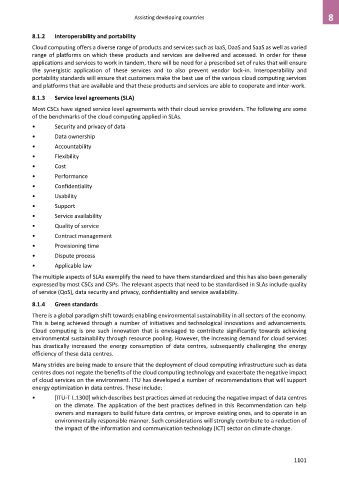Page 1109 - Cloud computing: From paradigm to operation
P. 1109
Assisting developing countries 8
8.1.2 Interoperability and portability
Cloud computing offers a diverse range of products and services such as IaaS, DaaS and SaaS as well as varied
range of platforms on which these products and services are delivered and accessed. In order for these
applications and services to work in tandem, there will be need for a prescribed set of rules that will ensure
the synergistic application of these services and to also prevent vendor lock-in. Interoperability and
portability standards will ensure that customers make the best use of the various cloud computing services
and platforms that are available and that these products and services are able to cooperate and inter-work.
8.1.3 Service level agreements (SLA)
Most CSCs have signed service level agreements with their cloud service providers. The following are some
of the benchmarks of the cloud computing applied in SLAs.
• Security and privacy of data
• Data ownership
• Accountability
• Flexibility
• Cost
• Performance
• Confidentiality
• Usability
• Support
• Service availability
• Quality of service
• Contract management
• Provisioning time
• Dispute process
• Applicable law
The multiple aspects of SLAs exemplify the need to have them standardized and this has also been generally
expressed by most CSCs and CSPs. The relevant aspects that need to be standardised in SLAs include quality
of service (QoS), data security and privacy, confidentiality and service availability.
8.1.4 Green standards
There is a global paradigm shift towards enabling environmental sustainability in all sectors of the economy.
This is being achieved through a number of initiatives and technological innovations and advancements.
Cloud computing is one such innovation that is envisaged to contribute significantly towards achieving
environmental sustainability through resource pooling. However, the increasing demand for cloud services
has drastically increased the energy consumption of data centres, subsequently challenging the energy
efficiency of these data centres.
Many strides are being made to ensure that the deployment of cloud computing infrastructure such as data
centres does not negate the benefits of the cloud computing technology and exacerbate the negative impact
of cloud services on the environment. ITU has developed a number of recommendations that will support
energy optimization in data centres. These include:
• [ITU-T L.1300] which describes best practices aimed at reducing the negative impact of data centres
on the climate. The application of the best practices defined in this Recommendation can help
owners and managers to build future data centres, or improve existing ones, and to operate in an
environmentally responsible manner. Such considerations will strongly contribute to a reduction of
the impact of the information and communication technology (ICT) sector on climate change.
1101

